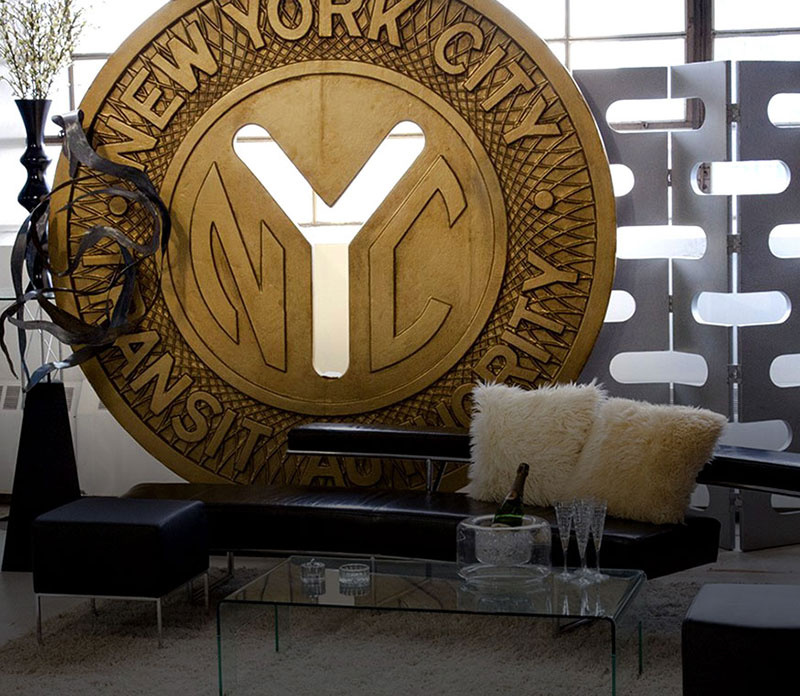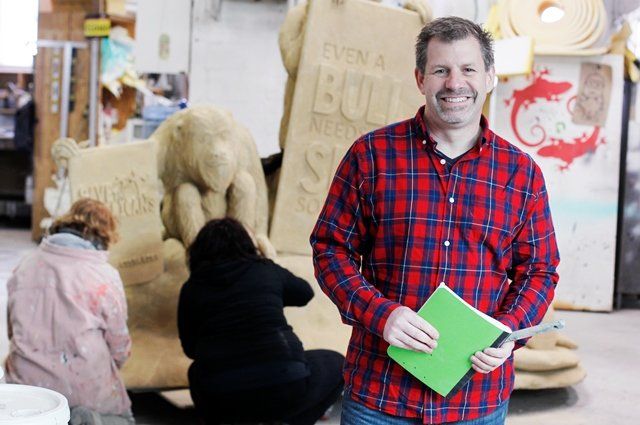Rahway company crafts props for stage and screen
HARLAN SILVERSTEIN may be the greatest Broadway success you've never heard of.
He's never belted out an 11 o'clock number and brought a crowd to its feet. He's never written show tunes. He's never received a Tony Award either -- in fact, he's never been eligible for a nomination.
But when you step inside his office, nestled inside a stark concrete warehouse in Rahway, you see dozens of Playbills -- "Gypsy," "Newsies," "Elf," "Matilda," "Jersey Boys" -- from shows he's helped develop.
Then, there are the monkeys. With red bows around their necks and cymbals ready to clang together, the little plush characters sharing a bench in a lobby are straight out of "The Phantom of the Opera."
They're made by the company Silverstein co-founded in 2003 -- The Spoon Group -- a one-stop prop shop that provides just about any item you can imagine, from animated primates to a replica of an airplane, for stage shows, films and events.
"Set (design) is absolutely beautiful, but it's four walls and a floor," Silverstein said during a recent visit to the warehouse. "We've got to put all the stuff in it."
As the sign on the door of The Spoon Group says, he and his staff of 42 specialize in metalwork, sculpture, furniture and special effects for all kinds of spectacles. On staff are engineers, architects, woodworkers, painters and upholsterers.
Lauren Madden of Old Bridge (left), a crafter; and Loren Mochari of Jamesburg, head of craft; work on a large promotion piece in the paint shop during production work at The Spoon Group in Rahway. 01/09/2015 FOR INSIDE JERSEY Jerry McCrea/Inside JerseyAt propNspoon in Rahway, Lauren Madden, left, and Loren Mochari work on a large promotion piece in the company's paint shop. Jerry McCrea
"All the people within all those facets are highly skilled, highly trained," Silverstein says. "We bring them all together in one place."
Silverstein approaches the unusual demands of his field -- Can his team make a replica of Big Ben in a weekend? How about an 8-foot-tall subway token? -- with a tinkerer's spirit and childlike exuberance that seems just right for someone who once wanted to be a toymaker.
His sky-blue eyes sparkle and reveal faint smile lines as he describes his projects and his path to an unusual and under-the-radar aspect of the arts.
After attending the School of Visual Arts in New York City, says the 46-year-old Connecticut native and former Titusville resident, he didn't want to work for Hasbro or Tyco as originally planned. "I wanted to design my own things," he says.
He began working in scene shops and gradually found his way into the production industry, starting his own company with business partner Kent Sweeney. In 2011, the company merged with a longstanding outfit, Props for Today, to become known as propNspoon.
In addition to the skills he needed to understand each facet of the prop business, SVA gave Silverstein his company name. As a student, he lived around the corner from the Gramercy Italian restaurant Lamarca. Each day, they made fresh pasta and, just before closing time, a certain art student would come to pick up the leftovers before they hit the trash bin. He shared his bounty with his fellow students. Because he fed everyone, a friend dubbed him "Spoon."
Silverstein got to channel the innate playfulness that got him started in the field for propNspoon's most recent project, "Peter Pan LIVE!," which aired on NBC in December.
When the Lost Boys sang "I Won't Grow Up," they danced on tables that were made in New Jersey. Although they looked like bamboo, the tables were actually forged out of treated aluminum to bear the weight of the actors. Before they were wrapped up and sent to the set, employees jumped on the tables to test them.
Hopping on furniture is not unusual in this workplace, which spans 58,000 square feet of warehouse space. Other days on the clock have involved testing out a scuba mask for "Seussical" that needed to blow bubbles and aerosol cans that sparked in "Hairspray."
Naturally, Silverstein's 8-year-old daughter Isabella likes to join him at work -- sometimes riding on a forklift past tables covered with heavy machinery.
A few years ago, when his house flooded, he allowed her to sketch the new bed she wanted -- and then help to build the full-scale version, which looked as if it were made for a mermaid, complete with a giant wave.
"It's like a giant sandbox," Silverstein says of the warehouse. "I'm really excited she loves doing those crafty things. I've taught her tool safety; she knows goggles and earplugs, and how to use staple gun and nailer. She used the band saw a couple weeks ago.
"What's great is that those are life skills to say, 'I'm going to put my own curtains up, hang a cabinet, screw this thing together.' I'm glad I have the opportunity to share this with her and teach her along the way."
While, in some ways, what Silverstein does can seem like a large-scale version of child's play, a tremendous amount of work and responsibility goes with each project. Last-minute requests can mean welding, carving and painting all weekend, and if flying is involved, there's an added element of danger.
"If we have a piano we have to store up in the air that weighs 300 to 400 pounds, the rig can't break and the piano can't fall," he says. "If it does, you could kill somebody."
Beside safety awareness, there's also quite a bit of mental ingenuity involved.
"What's great about designers is that they can draw these awesome pictures -- and they can draw impossibilities," he says. "You know, 'I want this, and I want this out of wood.' Well, wood doesn't bend that way."
When he's asked to achieve the unachievable, he says, "I love those moments. ... There's always a way to get the designers what they want."
One of Silverstein's most memorable challenges was a project for the movie "Sex and the City 2," during which the four friends fly to Dubai on Emirates airlines. Or so viewers thought.
"They tried to go to the airline manufacturer and it was too much time, too much money, but it had to look just like it," says Silverstein.
PropNspoon had 30 days to create life-size replicas of the plane's interior suites. Every door and sliding compartment had to function and be ready for a close-up, and there were all kinds of tricks to make each detail look real.
For example, Silverstein says, "behind the seats there are little speaker boxes that are curved."
"We made these small wood forms and we wrapped them with pantyhose. Then we brushed fiberglass resin on them."
Such imagination and craft is rarely recognized.
At the Tonys, for instance, sets, costumes, lighting, sound and orchestration are all up for awards, but not props. When he doesn't hear from a client, he assumes everyone's happy.
"You're like the people that get sort of brushed under the rug," he says. "But it's really more about the appreciation for the craft. ... It's a passion."
As one walks through the warehouse, there is a rainbow of paint cans, bolts of felt and shelves of foam furniture filling, and the smell of burning wood. Wooden planks and metal rods stretch to the ceiling like tree trunks, ready to be turned into parts of a new story.
Decontextualized bits of shows are scattered everywhere -- pieces of a mannequin of Burnt Ned from "Bat Boy" here, a giant birdcage from an event there, Sylvia the Nubian goat from an Edward Albee play reposing under a table.
When they're onstage, many of these items may elicit a smile or a look of wonder from an audience member, but only one will let them know who's behind the work.
That's the throne created for "The Phantom of the Opera." It is worth $75,000 and contains a black velvet seat that flips over to hide the actor playing the title role, when he seems to disappear near the show's end.
The chair's legs and arms are made of ornately carved silver and, within its sinuous lines, is the company's signature. It's noticeable only when it's pointed out, but then, it's unmistakable: a pattern of tiny spoons, giving due tribute to the ones who have filled the empty rooms of the stage, as Silverstein says, the ones who help "create the magic."


